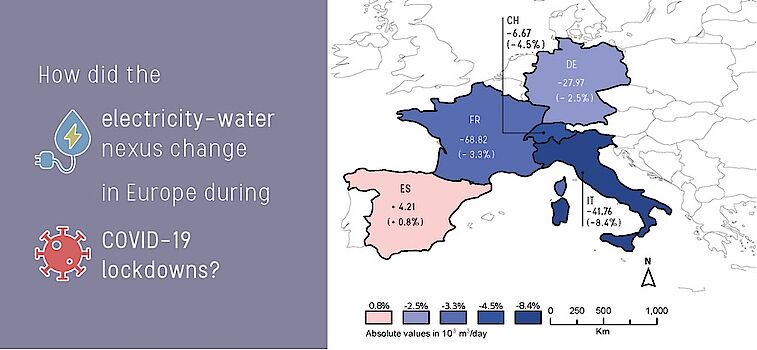When COVID-19 hit Europe in Spring 2020, it had massive impact on our daily life. Nearly all European countries implemented quarantine and lockdown-like measures to contain the spread of the pandemic. These lockdowns also affected the European economy and its electricity use. In a recent study, ECDF Professor Andrea Cominola joined forces with fellow researchers Mario Roidt, Christopher M. Chini and Ashlynn S. Stillwell to evaluate the short-term changes of the European water footprint of thermal electricity and related impacts on virtual water trade during the COVID-19 pandemic. The results of the study have recently been published.
“The main purpose of this research collaboration was to get a better understanding of the sensitivity of the electricity−water nexus in the European electric grid to large-scale behavior changes, as compared, for instance, to technological improvements or adoption of different energy mixes”, Andrea Cominola emphasizes. The researchers first investigated whether Europe as a whole showed any change in its electricity generation after the implementation of quarantine and lockdown-like measures. They computed the time series of daily electricity load from January 1, 2020, to April 19, 2020, and then analyzed its deviation from the average values observed in the same period between 2016 and 2019. Following this, they calculated the consumptive water footprint of thermal power plant operations in Europe and its changes during the COVID-19 lockdown-like measures. The related virtual water trade was then completed using the electricity trade data published in the European Network of Transmission System Operators for Electricity (ENTSO-E) Transparency Platform. ENTSO-E publishes different electricity data sets with hourly or subhourly time resolutions for all European countries at the national scale. The data sets from the past five years on load, generation aggregated by type, and physical flows over 25 European countries were used in this study, in particular the five countries with the highest absolute number of COVID-19 cases as of March 15, 2020, namely, Italy, Spain, France, Germany, and Switzerland.
As a result, the researchers found that the consumptive water footprint of thermal power plant operations in Europe decreased during the COVID-19 lockdowns, compared to the average of the past four years. Lower electricity demand is responsible for 16% (0.29×106m3/day) of the decline, while the rest is due to changes in the electricity generation mix towards less water-intensive technologies, mostly renewables. Virtual water trade associated with electricity was also affected: Italy, a hotspot of COVID-19, reduced its water footprint by 8.4% and its virtual water imports by 70,700 m3/day. Germany and France slightly reduced their domestic water footprint of electricity but increased their virtual water imports. “These findings contribute to better understand the dynamics in the electricity-water nexus in Europe. Better knowledge of these dynamics can support the design of future adaptive planning and management strategies aimed at ensuring the resilience of critical European networks and infrastructure systems.” Andrea Cominola summarizes.
The study is published in the Environmental Science & Technology Letters and freely available here.

